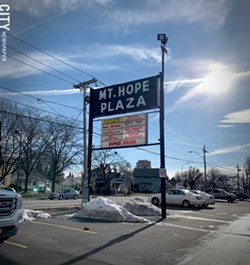Mt. Hope Avenue near the University of Rochester was transformed by College Town, a mix of restaurants, shops, offices, and apartments. It was built along a section of the avenue that stretches from Elmwood Avenue south to Rossiter Road and was the first phase of a major project to redevelop the Mt. Hope corridor.
The second phase of the project is supposed to redevelop the section of Mt. Hope Avenue south of College Town, from Rossiter Road to the city line. But many residents and business owners say that the city's plans aren't coming together as they expected.
They anticipated that the the city would bury the corridor's utility lines, just as they did in the College Town section of Mt. Hope. They want the utilities moved underground, but that's not in the city's plans.
How and when that decision was made has angered some business owners and residents. Getting information from the city about the plans for Phase 2 of the project, as well as cost estimates for it, has been difficult, says Bruce Mellen, president of the Upper Mt. Hope Neighborhood Association.
Mt. Hope is one of the main gateways into the city and the above ground utilities are an ugly distraction, says Dick Rowe, long-time owner of Rowe Home Theater, Audio, Camera and Video, at 1737 Mt. Hope Avenue, and the former president of the area's business association.

- PHOTO BY RYAN WILLIAMSON
- Mount Hope Plaza
Upper Mt. Hope is sometimes called the "white coat district" because of the large number medical students and staff that live there. The neighborhood has a delicate balance of single-family residences, apartments, professional offices, and small businesses.
"There are still families living here, there are still people who care," Rowe says.
Business owners and residents discussed moving the utilities underground at a neighborhood design charette in 2017, Mellen says.
During the charette, residents also said they want some changes to make Mt. Hope and adjoining residential streets safer, particularly for pedestrians. They asked for a traffic light and crosswalk at Mt. Hope Avenue and Shelbourne Road, a lower speed limit on Mt. Hope, and efforts to reduce through traffic in the residential areas, Mellen says.
A task force of business owners and residents has been working with the city on Phase 2 for four years, Rowe says. He also says that he repeatedly asked city officials about the plans for Phase 2.
Rowe and Mellen say say the city dragged its feet at getting the estimates for the underground work when there was still time to approach local and state legislators for the money or work with property owners on a small tax increase to help pay for the work.
"For four years I kept bringing this up; why aren't we talking about the cost of burying the utilities?" Rowe says.
Neighborhood leaders just heard from city officials a few weeks ago that the cost of the underground work was about $1.3 million, Mellen says. And that's why it's not part of the Phase 2 plan. City officials never promised to bury the utilities, Mellen says, but it's a huge disappointment.
"The problem boils down to communication," Mellen says. "We really don't know what's going on. You need to work with people on something like this and not design from a distance."

- PHOTO BY JACOB WALSH
- Bruce Mellen, president of the Upper Mt. Hope Neighborhood Association
A city engineering team examined the section of Mt. Hope Avenue south of College Town and determined that burying the utilities wasn't feasible, says Alex Yudelson, the city's chief of staff.
The team has worked through the conceptual planning and is now entering the preliminary design phase of the project and there isn't enough money for the underground work, Yudelson says. Putting utilities underground on the southern end of Mt. Hope isn't something that the city would normally do, Yudelson says.
"It's very different from the College Town area," Yudelson says.
But the city is going to make a major street improvement to the southern stretch of Mt. Hope Avenue. And the engineers will work with the residents on their traffic concerns as part of the design work, he says.
Neither Mellen nor Rowe are satisfied.
"Am I frustrated? Yes," says Rowe. "Am I angry? Yes. Do I think the city hasn't seriously engaged us? Yes."